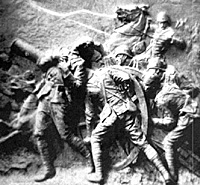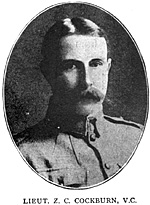 The action at Leliefontein is a classic example of a rear guard
action. In the successful defence of the column the 100 Canadian
troops in the rearguard earned three Victoria Crosses, one
Distinguished Service Order and a distinguished Conduct Medal. The
three VCs won on November 7th 1900 is the highest total won by a
single unit of the Canadian armed forces for a single days fighting.
The action at Leliefontein is a classic example of a rear guard
action. In the successful defence of the column the 100 Canadian
troops in the rearguard earned three Victoria Crosses, one
Distinguished Service Order and a distinguished Conduct Medal. The
three VCs won on November 7th 1900 is the highest total won by a
single unit of the Canadian armed forces for a single days fighting.
The story of this remarkable action is based on the accounts of two men who fought in the battle; Trooper AE Hilder, 2nd Troop, B Squadron, Royal Canadian Dragoons (RCD) had seen considerable fighting in South Africa. He reckoned "I was closer to death in the action at Lilliefontein (sic) than at any time during my service in South Africa.", and Lt EWB Morrison who played a pivotal role in the battle commanding left section D Battery Royal Canadian Artillery.
The Canadians were part of a column under the command of MajorGeneral HL Smith-Dorrien operating in the eastern Transvaal from their base at Belfast. The column, numbering about 1500 troops, was typical in composition, mainly infantry (King's Shropshire Light Infantry and Suffolk Regiment) with a few mounted men, some guns and a large wagon train. They had been out to find a Boer force and located a laager in a valley near the Komati River on November 6th. The laager was destroyed by shells from a 5' howitzer and the commandos dispersed. The Boer force was drawn principally from the Carolina (General IC Fourie and Commandant HR Prinsloo) and Ermelo (General J Grobler) commandos, with a few Middleburgers. All well respected by their men Prinsloo was the abrest of the three, a hero of Spion Kop. The British likened him to the great Boer leader General Christian de Wet.
March
The next day the force set out at 7:00am to march the twelve miles back to Belfast. The infantry the wagons and heavy guns set out first to secure a crossing over a spruit. Smith-Dorrien appointed the Canadian Mounted Rifles (CMR), commanded by Lieutenant-Colonel TD Evans, with two guns of the 84th Battery (Major CD Guinness), as right flank guard. The honour of forming the rearguard went to the Royal Canadian Dragoons (RCD) and D Battery, no more than 100 men.
 The RCD formed a crescent shape; from left to right were troops
commanded by Lt ZC Cockburn (at right), Lt REW Turner and Lt Sutton. Each
troop was divided into sections of six men. The RCD had a Colt gun,
which with D Battery, was positioned in the centre. The rearguard was
commanded by Lieutenant-Colonel Ff, Lessard, a soldier with much
experience fighting the Boers.
The RCD formed a crescent shape; from left to right were troops
commanded by Lt ZC Cockburn (at right), Lt REW Turner and Lt Sutton. Each
troop was divided into sections of six men. The RCD had a Colt gun,
which with D Battery, was positioned in the centre. The rearguard was
commanded by Lieutenant-Colonel Ff, Lessard, a soldier with much
experience fighting the Boers.
Deployed with scouts to the fore the rearguard sat down and waited for the transport and infantry to reach the ridge. The transport and heavy guns occupied about six miles of road and moved very slowly. While the ponderous column moved off a group from the Carolina commando appeared on the right flank to occupy a position overlooking the route of the column. The right flank guard spotted them and Lt-Col Evans galloped his tiny force of 60 men to reach the position before the Boers. The Boers, about 350 in number. tried to storm the kopje but the CMR assisted by the guns of the 84th Battery drove them off. As the Boers retired D Battery opened fire at a range of 5000 yards.
Rebuffed, but Resourceful
Rebuffed on the right flank the Boers began working their way towards the unprotected left flank. A message was sent back for reinforcements. With great forethought Lt Morrison sent his gun's ammunition wagons back for resupply, D Battery had only the rounds in its limbers, left.
During this time the rearguard was moving backwards (towards the column). The two guns (No. 5 and No.6) moved and fired alternately. Hilder estimated about 500 Boers were attacking them, pressing in on the flanks which compressed the line and caused the six man sections to become muddled up. During this retirement, riding with his section, three bullets hit Hilder's clothes and saddle, another hit his comrades horse. They "then separated for safety sake" when a shot killed Lance Corporal WJ Anderson.
At about 11 o'clock a Boer was sighted on the right signalling with a mirror across the battlefield to the left. D Battery put an end to his signals with a well aimed shell that sent the man scurrying for cover.
Just then the Boers began to drive in Cockburn who, with about 30 men, held the right corner. Lessard sent Morrison and No. 5 gun to support Cockburn. The gun was galloped over a mile and a half up a slope, unlimbering the gun was soon in action forcing the charging Boers to dismount and take cover. After only a dozen shells Lessard, himself galloped up ordering Morrison to fall back, pointing back over his shoulder towards more Boers charging at the left flank.
Both guns of D Battery were now not firing as they raced for the safety of the ridge in their rear. It was left to the rifles of the mounted men to stem the determined charge of the Boers. Cockburn dismounted his men to take cover amongst the grass and anthills. Seeing the gun limber up the Boers rode in to capture it but were surprised by Cockburn's group who held them up. All of Cockburn's troop were taken prisoner.
In the centre Hilder and his comrades were "converging on the ridge .... we could have used the help of the infantry ... the guns were in grave danger of being captured". Morrison described the Boer charge, a mile long 'firing from their horses. It looked like the spectacular finale in a wild west show.'
The horses drawing the guns now extremely tired were staggering up the slope. The gunners, dismounted, were pulling on the traces dragging gun and beast towards safety. Momson decided the best option was to halt where he was and bring the guns into action. The shrapnel shells made gaps in the ranks of the charging Boers but did not slow them down.
At the foot of the ridge Lt Turner organised a final stand shouting, "never let it be said the Canadians let their guns be taken." Dismounting, Hilder and his comrades crouched in the grass around the Colt gun. In the noise and confusion, the Boers were within 400 yards, not all heard Turner's rallying cry and he rode off with a shattered arm and a neck wound to round up reinforcements. As the RCD were re- grouping Pte WN Knisley rode to the assistance of a dismounted comrade (Cpl PR Price) bringing him into the tenuous shelter of the huddle of dismounted men.
Too Late
Intent on capturing the guns the charging Boers did not notice the dismounted Canadians until they were within 50 yards, by then it was too late. In a moment General Fourie and Commandant Prinsloo were shot down. The sudden loss of two highly respected leaders took the wind out of the Boer attack. Another leader, Veldt-Cornet AJ de Langer (Carolina Commando) was killed on this day.
The Colt gun was doing sterling work in keeping the Boers from overrunning the dismounted Canadians. At a critical moment it jammed. The gun's commander, Sgt E Holland, removed the barrel from the carriage and ran over to Hilder shouting for a horse. His own horse dead, Hilder handed him the reins of the nearest horse Holland leapt on the horse, the hot barrel tucked under his arm and galloped off the battlefield; "I saw him gallop off to safety and a V.C. " . Holland's prompt action was one of many that proved decisive. If the Boers had captured the gun they may have got it working and decimated The Canadians.
As Holland galloped off with the barrel of the Colt gun the Boers closed in to take Hilder and his comrades prisoner. A young Boer approached the unarmed Hilder threatening to kill him in revenge for his father being killed the previous day. As Hilder anxiously tried to dissuade the young Boer an older Boer rode up and ordered the young Boer away. While Hilder was desperately parleying for his life he heard a shot close by and saw Sgt N Builder fall fatally wounded.
 Photo at right: Lt. Holland (left) and Lt. Turner (right)
Photo at right: Lt. Holland (left) and Lt. Turner (right)
After taking Hilder's equipment the Boer told him to go. Unsure, Hilder asked him if he was going to shoot him to which the Boer replied "no - I want the guns !". With that Hilder ran the 200 yards to the spruit where he caught a stray horse and rejoined his squadron.
As the guns and the remaining Dragoons crested the ridge and dropped into the spruit General Smith Dorrien had returned with reinforcements, including Lt-Col Evans and the CMR. Three companies of the Shropshire Light Infantry, the guns of the 84th Battery and the pom-poms drove the Boers away. Smith-Dorrien was full of praise for the Canadians. In his report he recommended two officers; Lts Cockburn and Turner, and two men; Sgt E Holland and Pte WA Knisley for the Victoria Cross. Lt Morrison was recommended 'for special distinction '.
In the event the VC was awarded to Lts Cockburn and Turner and Sgt Holland. Lt Morrison was awarded the DSO and Pte Knisley the DCM. Pte Knisley, severely wounded at Leliefontein, was promoted to Corporal. He was killed at Hart's River on April 2, 1902. Sgt: Holland was commissioned in September 1902. No 5 gun, the 'Leliefontein gun' that Lt Morrison commanded on the day, was returned to Canada and is now on display in the Canadian War Museum.
Sources
'Lilliefontein', extract from Trooper AE Hilder's diary in
Sentiments of Celebration, Toronto Canada, 1951
With the Guns in South Africa, LT EWB Morrison,
Hamilton, Ontario 1901
Memoirs of Forty-Eight Years Service, General Sir H
Smith-Dorrien, John Murray, 1925
Our Little Army in the Field. The Canadians in South Africa
1899-1902, Brian A Reid, Vanwell Publishing, St Catharines
Ontario, 1996
Back to Age of Empires Issue 14 Table of Contents
Back to Age of Empires List of Issues
Back to MagWeb Master List of Magazines
© Copyright 1998 by Partizan Press.
This article appears in MagWeb (Magazine Web) on the Internet World Wide Web.
Other military history articles and gaming articles are available at http://www.magweb.com